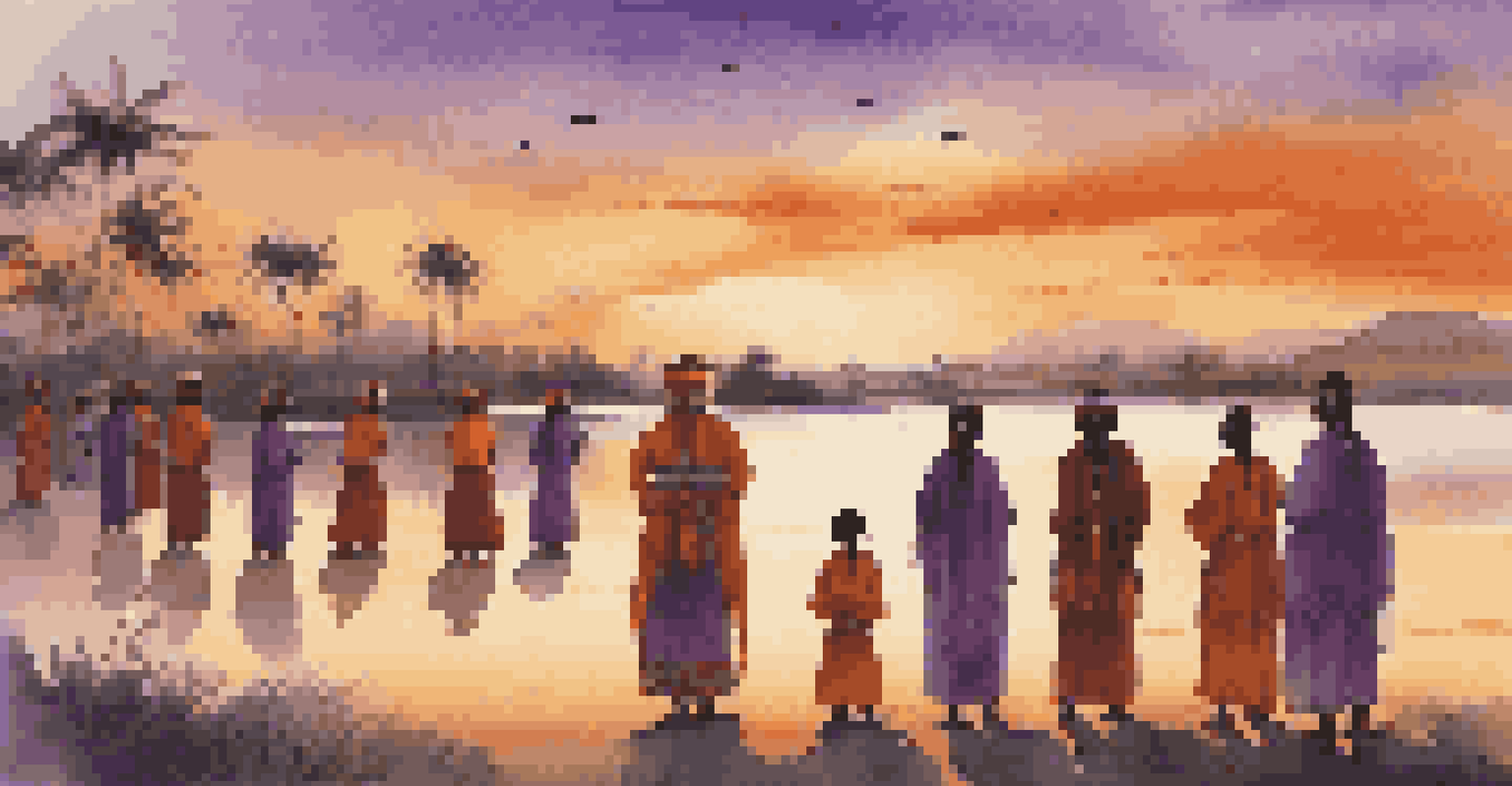The Role of Digital Media in Cultural Appropriation Debates

Defining Cultural Appropriation in Today's Context
Cultural appropriation refers to the adoption of elements from one culture by members of another culture, often without permission or understanding. This phenomenon can lead to the commodification of cultural symbols, stripping them of their original meaning. In today's interconnected world, cultural exchange is more common than ever, but it raises questions about respect and ownership.
Cultural appropriation is often a painful reminder of the inequalities that persist in our society.
Digital media amplifies these discussions by providing a platform where voices from marginalized communities can share their experiences and perspectives. Social media, in particular, allows for rapid dissemination of information and opinions, making cultural appropriation a hot topic in online forums. This accessibility means that debates about cultural appropriation can reach a global audience quickly.
The tension often lies in the fine line between appreciation and appropriation. While some argue that cultural exchange enriches societies, others feel that it can dilute or disrespect their heritage. Thus, the role of digital media becomes critical in navigating these nuanced discussions.
The Power of Social Media in Cultural Conversations
Social media platforms serve as a megaphone for individuals and communities to voice their concerns about cultural appropriation. Hashtags like #CulturalAppropriation and #StopAsianHate have gained traction, facilitating conversations that might not have occurred otherwise. These platforms enable real-time feedback and dialogue, allowing users to engage with diverse viewpoints.

Influencers and public figures also play a significant role in shaping public opinion on cultural appropriation. When celebrities are called out for appropriating cultures, the discussions often trend, leading to wider awareness and debate. This phenomenon illustrates how digital media can magnify the impact of cultural appropriation incidents.
Cultural Appropriation Explained
Cultural appropriation involves adopting elements from one culture by another without permission or understanding, often leading to the commodification of cultural symbols.
However, the same platforms can also be breeding grounds for misunderstanding and conflict. Miscommunication can occur when cultural nuances are lost in translation, leading to heated arguments rather than constructive dialogue. Therefore, it’s essential for users to approach these discussions with empathy and an open mind.
Case Studies: Digital Media and Cultural Appropriation
Several high-profile cases highlight the intersection of digital media and cultural appropriation debates. For instance, when a popular fashion brand released a clothing line featuring traditional Indigenous designs without permission, the backlash was swift on social media. Activists rallied online, urging the brand to acknowledge and rectify the harm caused.
The most effective way to combat cultural appropriation is to engage in open dialogues and educate ourselves about the cultures we admire.
Another example includes the criticism faced by celebrities for wearing traditional attire from cultures they do not belong to, which sparked widespread discussions on platforms like Twitter and Instagram. These incidents illustrate how digital media can mobilize support and foster community among those affected by cultural appropriation.
Moreover, these case studies stress the importance of accountability in the digital age. The immediacy of social media allows for rapid responses, prompting brands and individuals to reflect on their actions more critically than in previous decades.
The Role of Education in Cultural Appropriation
Education plays a vital role in understanding the complexities of cultural appropriation. Digital media can serve as a powerful educational tool, offering resources that help individuals learn about different cultures and the significance of their symbols. Online courses, documentaries, and articles can provide context that fosters respect and appreciation rather than appropriation.
Platforms like YouTube and podcasts have become popular avenues for educators and activists to share knowledge about cultural sensitivity. This kind of content encourages viewers to think critically about their own cultural practices and the implications of appropriating elements from other cultures. By engaging with these resources, users can develop a more nuanced understanding of cultural dynamics.
Role of Social Media in Activism
Social media platforms amplify discussions on cultural appropriation, allowing marginalized voices to share their experiences and push for accountability.
Furthermore, educational initiatives can promote cross-cultural dialogue, helping individuals appreciate the richness of diverse traditions while acknowledging the need for respect. By investing in education, digital media can help bridge gaps and foster greater understanding among different communities.
Navigating the Fine Line: Appreciation vs. Appropriation
Understanding the distinction between cultural appreciation and appropriation is crucial in today’s global society. Appreciation involves recognizing and valuing another culture while respecting its origins and significance. In contrast, appropriation often entails borrowing cultural elements without permission, leading to potential harm and disrespect.
Digital media can help clarify this distinction by fostering discussions that highlight the importance of context and intent. For example, sharing stories from individuals within a culture can provide insights into why certain practices are significant, allowing for deeper understanding. This approach encourages individuals to engage with cultures meaningfully rather than superficially.
Ultimately, the goal should be to cultivate cultural appreciation that honors origins and promotes dialogue. Through thoughtful engagement, the digital landscape can serve as a space for shared learning and mutual respect, rather than division.
The Impact of Digital Activism on Cultural Appropriation
Digital activism has transformed the landscape of cultural appropriation discussions, enabling rapid mobilization and advocacy. Activists leverage social media to raise awareness about instances of appropriation and to call for accountability among brands and individuals. This newfound power has reshaped how cultural issues are addressed and challenged in public discourse.
Campaigns and movements born from digital activism have led to tangible changes, such as brands reevaluating their marketing strategies or engaging in meaningful partnerships with cultural representatives. The reach of these movements highlights the potential for digital platforms to create positive outcomes and promote social justice. They empower individuals to take a stand and advocate for their cultures.
Education Fosters Cultural Respect
Educational initiatives in digital media encourage understanding of cultural significance, promoting respect and appreciation rather than appropriation.
However, digital activism can also face challenges, including online harassment and backlash. Activists must navigate these obstacles while maintaining their mission to educate and advocate for change. Despite these difficulties, the impact of digital activism remains significant in shaping conversations around cultural appropriation.
Looking Ahead: Future of Cultural Appropriation in Digital Media
As digital media continues to evolve, so too will the conversations surrounding cultural appropriation. Emerging technologies, such as virtual reality and augmented reality, may offer new ways to experience and interact with different cultures. However, these advancements also raise questions about authenticity and representation that will need to be addressed.
Future discussions may focus on the ethical responsibilities of content creators and brands in representing cultures. As platforms strive to become more inclusive, the demand for authentic voices and representation will likely grow. This shift could foster a more respectful approach to cultural exchange, ensuring that diverse perspectives are heard.

Ultimately, the future of cultural appropriation debates in digital media hinges on continued dialogue, education, and empathy. By cultivating an online environment that values respect and understanding, we can contribute to a more harmonious coexistence of cultures in the digital age.